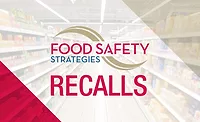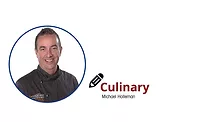Toward a Better American Product Recall System

The fact of the matter is, the nation’s food supply is not, and never will be, completely safe. To make food 100 percent sterile would destroy much of the taste, texture, nutritional value and enjoyment of eating. Instead, the food industry and public rely on an accurate and efficient food recall system to ensure the safety of food and minimize foodborne illnesses.
Unfortunately, the U.S. food recall system is ineffective,[1] but the good news is that the foodservice industry is taking important steps to improve recalls and keep Americans safe.
Our current food recall programs were developed around the time of the passage of the Bioterrorism Preparedness and Response Act of 2002. In November 2003, the U.S. Food and Drug Administration (FDA) issued a guidance document on product recalls that required suppliers to perform a Health Hazard Assessment to estimate the risk of the recalled product and determine the scope of the recall, or how deep into the food distribution chain (Figure 1) the recall should go.
The general assumption is, the more likely the product is to cause illness or death, the farther back into the chain the recall should extend. However, not all recalls are the same. In retail, the end-user is the consumer who purchased the product at the local grocery store to serve at home. In foodservice, the end-user is the restaurant or other institution preparing meals for the public.
Defining Recalls
The current system has established three classes of recalls that define three levels of risk. The reason, again, is accuracy. Recalls must be based on specific situations, and those situations should be spelled out clearly to the manufacturers and the customers and end-users in contact with the product.
A Class I Recall is defined as a situation in which there is a reasonable probability that the use of or exposure to a product will cause serious adverse health consequences or death.
A Class II Recall is a situation in which there is a remote probability that the use of or exposure to a product may cause temporary or medically reversible adverse health consequences.
A Class III Recall is a situation in which the use of or exposure to a product is not likely to cause adverse health consequences.
There is also a category of Market Withdrawal that occurs primarily when a product has a minor violation that would not be subject to FDA legal action or a quality issue is discovered by the manufacturer; for example, spaghetti sauce that is too runny. Usually, end-users are not notified and there is no government involvement.
Monitoring and maintaining the integrity of America’s food supply is a tough job, and federal and state public health and food safety systems do it admirably under some very challenging circumstances. However, our current recall classification system can also sometimes dramatically miss the mark with sometimes catastrophic consequences.
In 2008, the U.S. Department of Agriculture (USDA) ordered the recall of more than 143 million pounds of beef. The recall was designated a Class II, and the government repeatedly assured the public that there was “little likelihood of illness.” The USDA had video evidence that occasionally a postinspection cow would become nonambulatory and lie down (called “downer cattle”) before entering the slaughterhouse of meat processor Hallmark/Westland. In these situations, the cow is supposed to receive another inspection before being slaughtered. Instead, Hallmark workers used forklifts and prods to force downer cattle into the slaughterhouse. Even though there were no reported illnesses as a result, the federal agencies became concerned that downer cattle could have a brain disease called bovine spongiform encephalitis (BSE), or “mad cow disease.” An outbreak of BSE in the United Kingdom a few years ago led to a massive herd culling and several human deaths.
Although there has never been an outbreak of BSE in America, the USDA demanded that Hallmark recall all meat products produced from 2006 to 2008. While the 143 million pounds recalled is a massive quantity of beef, that number didn’t include hundreds of products, such as pizza or tacos, that contained beef from Hallmark. The recall forced Hallmark out of business almost immediately, and many of the company’s customers suffered millions of dollars in losses. This raises questions about the necessity and scope of this recall. If the recall was indeed justified, the federal agencies involved shared almost no information with the industry to support their actions.
Food Allergens and Other “Special” Circumstances
Scientists estimate that approximately 12 million, or about 4 percent, of Americans suffer from food allergies, mostly to the “big eight” allergens: milk, eggs, wheat, soy, nuts, peanuts, fish and shellfish. Allergic reactions range from short-term, mild discomfort to life-threatening anaphylactic shock. Failure to list a “big eight” allergen on a food label requires a recall of the product. Obviously, mistakes in listing allergens should be corrected, but is an all-encompassing food recall of every product the best approach? Rather than this one-size-fits-all approach, each situation should be evaluated independently to determine next steps.
A total recall is also mandated for products with unlabeled, nonallergenic ingredients. Recently, a supplier inadvertently added an ingredient to their products that contained monosodium glutamate (MSG). The USDA learned about the MSG several months later and forced the company to recall all products in the marketplace, resulting in millions of dollars in losses.
Administrative recalls, which involve a failure to obey a rule that does not pertain to food safety, can also be costly and challenging for companies. One administrative recall last year was mandated after the company was found to have “failed to comply with its Hazard Analysis and Critical Control Points (HACCP) plan.” In this case, that meant the company failed to sign a form listing steps being taken to control Listeria. There was no Listeria in the product and there were no illnesses, but all product was recalled because of a missing signature. Clearly, HACCP planning and compliance is necessary, but should an administrative error require the expense of a recall in every instance?
Growing Number of Recalls
The first annual FDA report on the Reportable Food Registry cites at least 200 Class I recalls from September 8, 2009, to September 7, 2010. That number grows significantly when including secondary or ingredient-related recalls. For example, the report lists an account of Salmonella in hydrolyzed vegetable protein that led to 1,001 additional reports to recall products that contained the contaminated ingredient.
As many in the food industry know, more than half of product recalls are market withdrawals because of quality issues unrelated to food safety. Unfortunately, most of the remaining are Class I recalls, although many are not always found to fit the definition of “reasonably likely to cause illness.”
This blurring of distinctions between Class I, II and III recalls often creates fear among the public, which increasingly believes every recall is life-threatening and may unjustly conclude that the nation’s food supply is unsafe.
Recall notices posted on government and supplier websites often contain a statement similar to the following: “While no one has reported illness, and we believe the food is safe, we are recalling this product in an abundance of caution.” This “abundance of caution” often ignores the Class I, II and III FDA standards for recalls and can cost American companies and consumers hundreds of millions of dollars annually.[2] The growing number of product recalls, and subsequent media coverage, has also had a numbing, “boy who cried wolf” effect on the public, making it difficult for individuals to know when to take a recall seriously.
The industry and public would benefit from a set of science-based rules to guide the food industry in better determining and defining the circumstances that should lead to product recalls. Fortunately, the industry is taking steps in this direction.
Conference for Food Protection (CFP)
In 2010, I submitted a proposal to the CFP, an organization of federal, state and local regulators, academia and food industry representatives, to form a Recall Evaluation Committee to evaluate the current recall definitions and system. That proposal was accepted and more than 50 CFP members have volunteered for the committee to achieve the following goals:
• Develop a classification system for food recalls that can be adopted by USDA, FDA and industry
• Create clarifying instructions and procedures to enable the industry and consumers to easily understand and comply with recalls
• Establish enforceable and reasonable time frames for execution of recall communications and actions
• Clarify the information required to be included in recall notifications
• Establish expectations for the notification of end-users, including restaurant and retail customers as well as school and institutional foodservice operators
These goals are not set in stone and are intended to stimulate ideas and discussion for improving the nation’s product recall system.
A New Model
Neither the public nor the industry truly understands the current models for recalling food. We have evolved to a point where the industry reaction to a recall notice is the same whether it is classified a Class I, II or III. In addition, the public doesn’t understand or know how to differentiate between the high-risk factors of a Class I and the low to nonexistent risks of a Class III recall. Now is the time for a new model that is simple, based on logic and science related to actual risk and structured to take guesswork and subjectivity out of the process.
For your consideration, I offer the following as a starting point toward a better American product recall system.
Because of the lack of distinction between classes of recalls, the word “recall” will be used only when there is a quantifiable risk to a significant segment of the population and there is no better way to stop consumption of a product. “Quantifiable risk” is defined below. Other less risky food events will be classified as “Food Alerts” and “Food Notices.”
A Product Recall Should be Initiated When:
• Consumption is likely to start, increase or continue a foodborne illness outbreak
• A reportable[3] foodborne illness agent is involved: Clostridium botulinum, hepatitis A, Giardia, Listeria, Vibrio, Salmonella, Shiga plus Escherichia coli, Shigella, Campylobacter, etc.
• The reportable agent is in the food, or there is strong epidemiological evidence linking a food to an outbreak of that agent
A Food Alert Should Be Issued When:
• A reportable agent is found in the environment of a plant OR
• At worst, consumption may result in short illness treatable with over-the-counter medicines and/or with a low attack rate OR
• Consequences may be more serious (e.g., an allergic reaction), but few persons would be affected and a public alert should be adequate OR
• The product may contain an agent that will be killed under normal preparation (not an adulterant)
A Food Notice Should Be Issued When:
• There is an ingredient left off the label, or the label is otherwise improper or misleading but not a risk to health
• The manufacturer failed to follow administrative rules, but that failure does not present a health risk
• There is a problem with quality or performance that the manufacturer wishes to publish
Naturally, the actions in each step above require vastly different levels of involvement and expense. A Product Recall demands an all-out, immediate effort to remove all product from the marketplace along with efforts to inform the public. A Food Alert should notify distributors, retailers, final sellers and others interested in receiving such alerts. Individuals receiving an alert could return products for a credit if they are impacted. Finally, a Food Notice is a press announcement that describes a product flaw that does not involve the safety or quality of a product.
All of us in the food industry share the goal of manufacturing, delivering and preparing the safest, highest quality food possible. The CFP Recall Evaluation Committee welcomes your feedback on how we can accomplish that goal on a more consistent and fair basis that preserves public safety without unnecessarily harming manufacturers. Please contact me at greg.pallaske@usfood.com, and I can share your feedback with my peers on the Recall Evaluation Committee. Working together, we can make a difference.
Greg Pallaske is director of regulatory compliance for U.S. Foodservice. He was formerly chief of food safety for the Wisconsin Department of Health and is a Registered Environmental Health Specialist. The views expressed in this article are those of the author and do not necessarily reflect the views of U.S. Foodservice, Inc.
References
1. www.gao.gov/new.items/d0551.pdf.
2. A recall in the first quarter of 2009 cost Kellogg’s $27 million. The Hershey Company spent $14.5 million in 2006, and General Mills reported that voluntary recalls cost them $24 million in 2009.
3. A list of reportable foodborne agents should be redefined for this project. >
Looking for quick answers on food safety topics?
Try Ask FSM, our new smart AI search tool.
Ask FSM →








